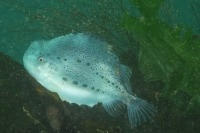
(Photo: Claire Goodwin)
Lumpfish
Cyclopterus lumpus
Lumpfish have a humped back with a row of tubercles along the middle and three rows of tubercles on their sides. There are also smaller tubercles scattered between the rows. They are usually green, grey or blue but spawning males have a reddish or orange colour. Their ventral fins are modified to form a suction ring. They can reach up to 60 centimetres in length and weigh up to 9.5 kilograms, but mature individuals are more commonly around 37 centimetres. Males are much smaller than females.
Authority
Linnaeus, 1758
Classification Details
Phylum: Chordata (chordates); Subphylum: Vertebrata (vertebrates); Class: Actinopterygii (ray-finned fishes).
Habitat
Found in the North Atlantic Ocean. In the northwest Atlantic, reported from the Davis Strait to the Gulf of Maine. In the eastern Atlantic, found from the White Sea to Portugal. Adult lumpfish are semi-pelagic (live in the water column) but spend time near the seabed in the winter. They migrate into shallow, inshore rocky sites in early spring to breed. Young lumpfish are often found under floating seaweed. Adults use their suckers to attach onto various human-made and natural substrates.
Diet
Predator. Mainly feeds on planktonic organisms such as sea jellies, comb jellies, and crustaceans. However, will also eat species living on the seabed and seaweed such as worms and sea squirts.
Reproduction
Lumpfish live offshore in winter but migrate into shallow inshore sites in early spring to breed. They display a strong homing ability and return to the same areas year after year. Males arrive first and establish nest sites. They then court females for several hours with a ritual including nest-cleaning, fin brushing, and body quivering. When persuaded, the female lays her eggs, and the male fertilizes them. The male protects the eggs for six to seven weeks, until they hatch. He removes predators such as the green sea urchin. He will also fan the eggs with his fins to oxygenate them. After hatching, the larvae disperse into the sea. They live near the surface for around a year and are often found in association with clumps of floating seaweed. Adults become sexually mature at around six years and are thought to live for up to 13 years.
Fun Facts
People eat the eggs (roe) of the lumpfish as caviar: a substitute for caviar from sturgeons. Canada was the leading exporter of lumpfish roe in the 1980s and 1990s.
People also use lumpfish to control sea lice at some salmon farms: they eat the lice off the fish!
References
FAO. Species Fact Sheets – Cyclopterus lumpus. FAO FishFinder. http://www.fao.org/fishery/species/2537/en Accessed online 20 January 2020. Froese R and Pauly D (2020). FishBase. Cyclopterus lumpus Linnaeus, 1758. Accessed through: World Register of Marine Species at: http://www.marinespecies.org/aphia.php?p=taxdetails&id=127214 Accessed online 20 January 2020. Reeds KA (2008) Cyclopterus lumpus Lumpsucker. In Tyler–Walters H. and Hiscock K. (eds) Marine Life Information Network: Biology and Sensitivity Key Information Reviews, [on–line]. Plymouth: Marine Biological Association of the United Kingdom. Available from: https://www.marlin.ac.uk/species/detail/1531 Accessed online 20 January 2020. Robins CR and Ray GC (1986) Atlantic Coast Fishes: Peterson Field Guides. New York: Houghton Mifflin Company. Scott WB and Scott MG (1988) Atlantic fishes of Canada. Canadian Bulletin of Fisheries and Aquatic Sciences 219, 731p.

